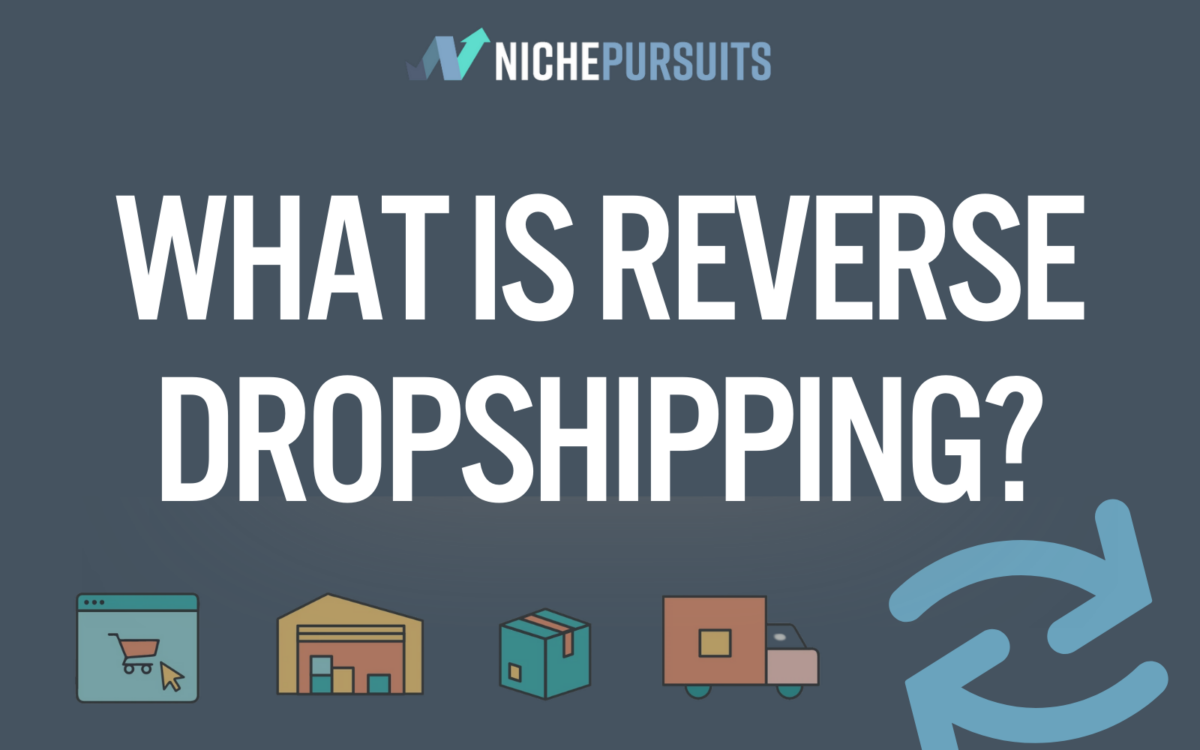What Is Reverse Dropshipping? The Definitive Guide

When you buy something through one of the links on our site, we may earn an affiliate commission.
You probably know about , but ? It’s an emerging that involves to traditionally exporting countries.
There is a lot of potential for profit using this model. However, the barriers to entry can be prohibitive. So, to make things easier, we’re going in-depth on the ins and outs of reverse .
Contents
?
Both and reverse involve taking orders from customers then sending them to a or manufacturer for .
The key difference is that regular usually involves ordering each from a country like China or India to be sent to customers in the United States or Europe. Reverse involves customers in countries like India or Thailand ordering products from the United States or Europe.
On the surface, this may not seem like the most profitable idea. However, there is tons of money concentrated in traditionally exporting countries. Many of these people are looking for products from the United States and Europe or Canada as these products are deemed to be superior to what they can buy in their home countries.
According to the World Bank's Changing Wealth of Nations 2018:
The top 20 countries with the fastest-growing wealth per capita were dominated by developing countries—including two of the biggest—China and India
What Are The Pros Of A Reverse ?
Reverse can be a high risk to high reward situation. The upsides are great with profit margins being higher and lots of potentially untapped demand. However, you are dealing with foreign countries where the laws and language are likely different from your own.
Some of the more prominent upsides to the reverse include the following:
Higher Profit Margins
You may not believe it, but middle and upper-class individuals in countries outside of Europe, the United States, and Canada are often willing to pay way more than what you would for the same .
In many cases, this is due to the fact they are already paying more for American and European products. Taxes, tariffs, and higher costs, as well as higher markups, lead to them paying more for the same .
You can use this to your advantage by finding gaps in the marketplace for in-demand products. The you can charge will be higher than selling the same in the United States or Europe.
Lower Competition
Because fewer people are to these countries, there will be less competition than in the United States, where thousands to hundreds of thousands of dropshippers compete for .
The majority of the businesses to primarily exporting countries will be larger importers or big-box . However, as a , you have an advantage over them because you have a lower overhead.
Larger businesses will only be able to import the most popular products. This leaves a gap in the marketplace for products in lesser demand.
Opportunities For Brand Building
Branding is the bread and butter of , which holds for reverse . You can create a strong brand that people associate with reliability and quality in your end destination.
You can even white-label products made in your home country to help create your brand. In the beginning, you will likely need to sell other brands, but as you learn what works and what doesn’t, you can begin to substitute other people’s brands for your own.
Over time, you may find that you can create an extremely lucrative brand allowing you to move away from .
Potentially Larger Audience
Many of the markets in developing or primarily exporting countries are untapped. This means there are more for a than in your home country.
Take Southeast Asia, for example, with over 670 million people. Countries in Southeast Asia such as Thailand, Vietnam, Indonesia, Malaysia, and the Philippines are experiencing rapid modernization and a growing middle and upper class.
These people are looking for products to purchase and very likely finding gaps in the marketplace for the exact products they want. You can exploit these gaps to target a much larger audience than you could in your home country.
Cheaper Marketing And Advertising Costs
Marketing and advertising are often cheaper in foreign countries, with competition less fierce. This doesn’t hold across all channels, but you will likely find that PPC (pay-per-click) and SEO (search engine optimization) are a lot less competitive.
If you are serious about creating a sustainable long-term business, the best thing you can do is hire a local company to conduct market research. This will take a bit of upfront investment, but it will give you a complete picture of the marketing terrain and let you know where you will get the most bang for your buck.
Easier To Offer Better
After living in Southeast Asia for over six years, I can confirm that leaves a lot to be desired. That’s a good thing for you as it’s one more area you can compete on compared to larger import-export companies in the region.
Superior service, in this case, means responding quickly to inquiries, offering a better user experience on your website, and being clear about what you are selling. Language barriers may exist, but you will find these easily overcome by hiring a local virtual assistant.
What Are The Cons Of A Reverse ?
As mentioned already, there are some significant upsides to reverse and some substantial downsides. Because you are likely dealing with people in a country that speak a different language, getting your message out will be more challenging.
Some of the other downsides to include:
Potential Difficulties Finding Marketing Channels
The nice thing about marketing to people who speak the same language and come from the same culture is that you understand how to reach them.
Now try and get your message to someone in a foreign country who speaks a foreign language and uses different tools and social media sites.
Finding the proper marketing channels in a foreign country is difficult. The way around this is to work with local marketing experts to help you build a solid brand and develop the proper marketing channels.
More Barriers To Entry
Aside from differences in language, you will also find other barriers to entry, including cultural differences and government regulations. None of these are impossible to get around, but you will need to put in the extra work.
Make sure when you are looking at countries to to, that you do your due diligence to understand the market and the local culture. The more thorough your research is when getting started, the better your odds of long-term success.
Unpredictable Regulations

One of the things I learned from living in Southeast Asia is that laws in developing countries seemingly change by the day and sometimes by the hour.
Nothing is set in stone in these places, and new regulations and bureaucratic red tape are standard. Take craft beer in Thailand. Craft brewing is illegal, so manufacturers would make their brews in surrounding countries and import them back into Thailand.
Stories like these aren't uncommon. Depending on what you want to , you may find yourself dealing with similarly nonsensical and cumbersome regulations. It may help to speak with a local attorney before getting started to ensure you are in compliance with local laws.
Have To Deal With Tariffs
In many countries around the world, you will be dealing with taxes and tariffs. This is especially true in exporting countries with heavily protectionist policies to protect their local manufacturers.
Before doing business in any country, you will need to speak with an accountant and an attorney. These local experts can help you get started the right way and ensure you don’t fall afoul of local laws, leading to your packages getting seized by customs.
Potentially More Difficult Sourcing Products
Because you are sourcing products from countries that traditionally import, you may find it more challenging to find the right items to sell. You will need to contact manufacturers directly and may need to set up relationships with companies not used to .
This doesn’t have to be an insurmountable obstacle. In the United States and throughout Europe, many companies are set up for . However, finding them will be more challenging than just a search on Alibaba.
Try using manufacturers’ directories such as Thomas Net and calling companies directly. This may be time-consuming but will likely give you the best results.
How Can You Get Started Reverse ?
Don’t let the downsides to a reverse discourage you. Many successful people are making great money using this business model. The many challenges to getting started mean that fewer people will be willing to stick it through.
Here are some actionable first steps you can take to get started in reverse .
Figure Out Which You Want To Operate In
Before you get started, you must find a currently underserved . Unlike , you likely won’t be able to load some products up on and get some quick sales.
You need to conduct market research, which may mean hiring a local expert to help you traverse unfamiliar territory. The best way to start will be through a gap analysis. This will tell you where the most demand is and give you a few different ideas for getting started.
Source Your Products
Once you’ve selected a solid to start in, you will need to source high-quality products from Europe and the United States, or Canada. Two of the best sources to start with are US Direct and Spocket (check out our Spocket review).
Even better will be to contact manufacturers directly and see if you can establish a relationship. Be very clear with them that you plan on mailing products abroad. They may already be set up to in the United States and therefore open to abroad as well.
Figure Out The Best Platform For Selling Products
This will go hand in hand with finding the proper marketing channels. Many countries don’t use and eBay. You may also find that they have different social media apps or that websites aren’t too common.
China, for example, isn’t that big on using websites and instead operates primarily through the mobile app WeChat. Thailand is another example where most sales are made through Instagram or the Line app. You will need to go where your customers are if you hope to succeed.
Write And Translate Your Descriptions
Regardless of where you end up posting your products, whether social media, an platform, or a website, you need to translate descriptions.
Don’t rely on Google Translate or a similar tool. These translation programs often get things wrong, and your copy may lose context or end up culturally inappropriate. Instead, you will need to hire a local translator.
An experienced translator will translate everything over without losing the meaning. Having clearly translated descriptions will reduce the likelihood of having to deal with or exchanges due to misunderstandings.
Choose The Best Channels For Marketing Each
Finally, you need to amplify your message and invest some money in marketing. You can’t just rely on people organically finding your products, especially if they don’t know where to look.
It’s highly encouraged to consult with a local marketing expert or a agency that understands how to market to the locals. They can inform you on the best channels and ensure you aren’t wasting your ad spend.
Local marketers can also work with you to present your products in the right way to increase the chances they sell and potentially help you raise your prices.
Common Questions About Reverse
To help further address the topic of reverse , here are some of the most frequently asked questions on the subject:
Where can I source products for a reverse ?
The best place to source for reverse is through services like US Direct or directly from US and European manufacturers. For the latter, you will need to work out a deal with the manufacturer directly, as they may not be familiar with overseas.
How Can I Market Products In Foreign Countries?
The best way to market dropshipping in a foreign country is to figure out what local businesses in the country use (and you'll probably also be interested to read our Ecomhunt review it not only helps you find products but gives insights into how to market them too).
In China, for example, WeChat is one of the most common advertising methods. Consider working with a local marketer if you have the budget for better results.
Is Reverse Legal?
Reverse is legal in most cases. Because you are each to foreign countries, you will need to be up to date with the laws in that country. You should also pay attention to international trade restrictions and trade blacklists.
? The Final Verdict
Reverse isn’t going to be a suitable for everyone. It requires persistence, a lot of patience, and the ability to quickly make decisions in the face of constantly changing rules and regulations.
The upsides to finding success with reverse though, can be immense. You will find that you have greater potential to explore largely untapped markets hungry for high-quality products.
If, after reading through all of this, reverse doesn’t sound like the right option for you, read through our guide to setting up a regular to see if it’s a better fit.
How To Start A Dropshipping Business With No Money And See Results
Want to learn step-by-step how I built my Niche Site Empire up to a full-time income?
Yes! I Love to Learn
Learn How I Built My Niche Site Empire to a Full-time Income
- How to Pick the Right Keywords at the START, and avoid the losers
- How to Scale and Outsource 90% of the Work, Allowing Your Empire to GROW Without You
- How to Build a Site That Gets REAL TRAFFIC FROM GOOGLE (every. single. day.)
- Subscribe to the Niche Pursuits Newsletter delivered with value 3X per week
My top recommendations
















